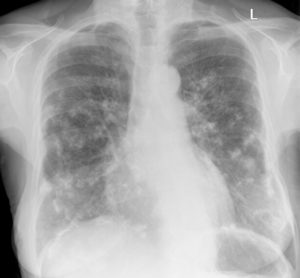Malignant pleural mesothelioma is cancer of the lining of the lungs caused by asbestos exposure. Symptoms include chest pain, trouble breathing, and a persistent cough. The average life expectancy for pleural mesothelioma patients is 18 months.
Treatment can be costly and insurance may not cover everything — but compensation may be available. Call (800) 647-3434 now to see if you qualify.
What Is Pleural Mesothelioma Cancer?

"[Pleural] mesothelioma is a cancer of the lining of the chest. Many people think it might be lung cancer, but it actually isn’t, and it’s not caused by smoking. It’s caused by asbestos exposure."
– Dr. Robert B. Cameron, Pleural Mesothelioma Specialist
For help paying for life-extending pleural mesothelioma treatment, work with an experienced mesothelioma law firm like Sokolove Law. We may be able to help you receive compensation through a legal claim.
Billions Recovered Nationwide
At Sokolove Law, we’ve recovered over $4.9 Billion for thousands of mesothelioma patients and their families nationwide. Let us get you the results you deserve.
Pleural Mesothelioma Causes
The only known cause of pleural mesothelioma is asbestos exposure. Even just one exposure could lead to this aggressive cancer.
Pleural mesothelioma develops in the following way:
- A person breathes in loose asbestos fibers floating in the air
- These tiny, nearly indestructible asbestos fibers become stuck in the pleura
- The fibers cause inflammation and damage the DNA of nearby cells
- Over 20-50 years, damaged cells may mutate in ways that lead to uncontrolled growth
- This uncontrolled cell growth in the lung lining causes pleural mesothelioma
People who worked in environments known to contain high amounts of asbestos, like shipyards and construction sites, have higher rates of this cancer.
If you've been diagnosed with mesothelioma, the odds are fairly good it's not your fault. It wasn't from your tobacco smoking habit if you had one, and it wasn't from any other vice you can think of.
It was probably because you were exposed to asbestos in your job. That's likely how, you know, the vast majority of our clients are exposed.
Because it's not your fault and it should never have happened to you, you have a right to make a claim against the folks who knew it was gonna happen to you and did nothing about it. The average worker did not know that it was dangerous.
But the reason why we're able to bring claims against the manufacturers who used asbestos in their products is because they knew it was dangerous.
If you or a loved one has been diagnosed with mesothelioma, Sokolove Law is here to help. Call us today.
Who Is at Risk for Pleural Mesothelioma Cancer?
Anyone exposed to asbestos may be at risk of developing pleural mesothelioma. However, some people are at an increased risk due to their occupation or other factors.
Those at high risk of developing pleural mesothelioma include:
- Blue-collar workers: From the 1930s to the 1980s, the United States construction and manufacturing industries exposed millions of workers to asbestos.
- Veterans: The U.S. Military used thousands of different asbestos-containing products throughout the 20th century, especially in the U.S. Navy.
- Loved ones of individuals exposed to asbestos: Workers may have unknowingly brought home asbestos fibers on their hair and clothing, exposing family members.
- People living near asbestos deposits: Rarely, people living near a natural deposit may be exposed to asbestos, especially if fibers are disturbed by mining.
Pleural mesothelioma primarily affects men, while peritoneal mesothelioma, which develops in the lining of the abdomen (peritoneum), largely affects women.
Call Sokolove Law right now at (800) 647-3434 if you’ve been diagnosed with mesothelioma or another asbestos-related disease.
Pleural Mesothelioma Symptoms
The symptoms of pleural mesothelioma mainly affect the lungs and chest. These symptoms often resemble common illnesses like the flu or pneumonia.
Symptoms of pleural mesothelioma include:
- Chest pain
- Coughing up blood
- Fatigue
- Fluid buildup in the lungs (pleural effusions)
- Overall declining health
- Persistent cough
- Shortness of breath
- Trouble swallowing
- Unexpected weight loss
It can take between 20-50 years for these symptoms to appear after initial exposure to asbestos.
If you are experiencing pleural mesothelioma warning signs, tell your doctor about your symptoms and any asbestos exposure history you may have.
Want to Talk to a Nurse?
Get in touch with one of our registered nurses who can answer any questions about your diagnosis or treatment options.
Pleural Mesothelioma Diagnosis
Diagnosing pleural mesothelioma can be challenging even for experienced cancer doctors (oncologists).
Mesothelioma is best diagnosed by a mesothelioma specialist, who will use a patient’s asbestos exposure history, imaging scans, and a biopsy to see if a patient has pleural mesothelioma.
Imaging Tests


In most cases, imaging tests like chest X-rays and computer tomography scans (CT scans) cannot exclusively confirm a mesothelioma diagnosis.
Biopsies
If imaging scans reveal signs of pleural mesothelioma, a pathologist will perform a biopsy, which is a procedure that removes a small fluid or tissue sample from a patient’s body to test it for a disease.
A biopsy is the only way to confirm a pleural mesothelioma diagnosis.
Getting a Second Opinion
Many patients with pleural mesothelioma are misdiagnosed because this type of cancer is usually difficult to tell apart from other lung-related illnesses, even with diagnostic tests.


For this reason, it is important for patients to get a second opinion from an experienced pleural mesothelioma doctor to confirm their diagnosis.
An accurate diagnosis for a patient’s cancer type and stage often leads to more effective treatment options.
Diagnosed with Mesothelioma?
You may be eligible for compensation that we can fight for on your behalf. Get the help you deserve now.
Pleural Mesothelioma Prognosis
Pleural mesothelioma patients generally have a poor prognosis, which is the expected progression of their cancer. Prognosis consists of two estimates: life expectancy and survival rate.
For a pleural mesothelioma patient, the life expectancy is around 18 months on average. That said, every patient’s prognosis is different and is dependent on their disease stage, cell type, age, and overall health.
Survival rate is a percentage estimate of how many patients live beyond a certain number of years. For pleural mesothelioma, the overall 5-year survival rate is 12%.
It’s important to remember that a prognosis is only an estimate. Some patients outlive their life expectancy by years and even decades.
4 Pleural Mesothelioma Stages
Doctors recognize 4 pleural mesothelioma stages, which describe how far the cancer has spread and help doctors determine the best treatment plan for a patient.
Pleural mesothelioma is the only mesothelioma type to have an official staging system (the TNM system).


Stage 1
Stage 1 pleural mesothelioma (earliest stage) typically has the best prognosis because the majority of patients qualify for life-extending surgery.
Average Life Expectancy of 21 Months


Stage 2
Pleural mesothelioma patients diagnosed during stage 2 are usually good surgery candidates.
Average Life Expectancy of 19 Months


Stage 3
Most pleural mesothelioma patients are diagnosed during stage 3, when their symptoms start to become more obvious. Generally, the cancer has spread too far to remove all of it.
Average Life Expectancy of 16 Months


Stage 4
During stage 4 pleural mesothelioma (final stage), patients usually no longer benefit from life-extending surgery. Instead, treatment is focused on reducing pain and increasing comfort.
Average Life Expectancy of 12 Months
Pleural Mesothelioma Cancer Treatment
Pleural mesothelioma is usually treated with a combination of surgery, chemotherapy, and radiation therapy (multimodal treatment). Those eligible for surgery usually have the best survival rates.
Unfortunately, critical life-extending treatment is costly and too often out of reach for patients.
That is why Sokolove Law has remained committed to fighting for compensation for those diagnosed with mesothelioma for over 40 years.
Get Help Paying for Treatment
Our mesothelioma lawyers can fight on your behalf for the compensation you need. Take the first steps toward justice now.
Surgery
Curative surgery is the most effective treatment for pleural mesothelioma. The goal of this treatment option is to remove as many visible tumors from a patient’s chest cavity as possible.
The 2 main surgeries for pleural mesothelioma are:
- Extrapleural pneumonectomy (EPP)
- Pleurectomy/decortication (P/D)
In most cases, only patients with early-stage (stages 1 and 2) cancer who are in good health can undergo surgery.
Chemotherapy
Pleural mesothelioma chemotherapy uses cancer-killing drugs (usually a combination of cisplatin and pemetrexed) to limit the spread of cancer cells and tumor growth.
Chemotherapy can be administered before, during, or after surgery to improve the survival time of pleural mesothelioma patients. However, this treatment commonly causes side effects like nausea and hair loss.
Radiation


Although radiation may be an effective way to slow cancer growth and manage painful symptoms, it may also damage healthy lung tissue.
Clinical Trials
Pleural mesothelioma cancer patients may be able to access promising new treatments like immunotherapy, targeted therapy, or photodynamic therapy by participating in a clinical trial.
For help locating a clinical trial near you, contact our support team today.
Palliative Treatment
Patients ineligible for surgery can still receive palliative care to help minimize discomfort and manage the symptoms of mesothelioma.
Palliative treatments for pleural mesothelioma include:
- Thoracentesis: Drains pleural effusions to relieve shortness of breath and chest pain
- PleurX™ Catheter: Allows patients to drain pleural effusions by themselves at home instead of going to the hospital
- Video-Assisted Thoracoscopic Surgery (VATs) and talc pleurodesis: Stops repeated pleural effusions by sealing the two layers of the pleura with talc
Pleural Mesothelioma Compensation Options
Although pleural mesothelioma treatment can be too costly for many families, there are forms of compensation available to victims of this cancer and their families.
Pleural mesothelioma compensation options may include:
- Mesothelioma lawsuits filed against the companies that made or sold the asbestos products you were exposed to
- Asbestos trust fund claims against any asbestos product manufacturers that may have since declared bankruptcy
- VA benefits for veterans with asbestos-related illnesses from military service exposure
When you work with Sokolove Law, our pleural mesothelioma lawyers can handle every step of the legal process for you, from finding the evidence to filing your claim. We are here to help you.
Legal Help After a Pleural Mesothelioma Diagnosis
A pleural mesothelioma diagnosis can be very stressful for families. The shock of a diagnosis and the associated costs of treatment can bring problems without easy answers.
For this reason, Sokolove Law is dedicated to helping victims of mesothelioma access financial compensation, which can be used to pay for treatment or other expenses.
As an experienced mesothelioma law firm, Sokolove Law has recovered over $4.9 Billion for victims of asbestos exposure and mesothelioma.
Our firm has over 40 years of experience in filing legal claims against major asbestos-related companies on behalf of families like yours.
To learn if you may be able to access compensation, get a free legal case review now.
Pleural Mesothelioma Cancer FAQs
What causes pleural mesothelioma?
Exposure to asbestos is considered the main cause of pleural mesothelioma cancer. When inhaled, the microscopic asbestos fibers settle in the lungs for decades.
The fibers then cause inflammation and damage the sensitive tissue lining the lungs, eventually leading to cells mutating and becoming cancerous.
How many stages of pleural mesothelioma are there?
There are 4 stages of pleural mesothelioma. Each stage describes how far the cancer has spread and helps doctors determine the best treatment plan for a patient.
The 4 stages of pleural mesothelioma cancer are:
- Stage 1: As the earliest stage, the mesothelioma tumors are localized in the lungs and/or chest cavity.
- Stage 2: At this stage, the cancer cells are beginning to spread to multiple layers of the lung tissue and maybe even the diaphragm.
- Stage 3: Beginning its more advanced stages, the cancer cells have spread more widely and possibly impact lymph nodes. However, the tumors may still be treatable through surgery.
- Stage 4: At stage 4 or late-stage pleural mesothelioma, the cancer has spread throughout the body, making it more difficult to treat through surgery or other methods.
Who are the top pleural mesothelioma specialists?
There are several thoracic surgeons across the nation who specialize in diagnosing and treating pleural mesothelioma.
A few of the top mesothelioma doctors are:
- Dr. Abraham Lebenthal
- Dr. Jacques Fontaine
- Dr. Robert B. Cameron
For help connecting with a pleural mesothelioma specialist, contact Sokolove Law.
Is pleural mesothelioma curable?
There is no cure for pleural mesothelioma at this time. However, some treatment options can increase a patient’s life expectancy by several months to a few years.
Can a chest X-ray show mesothelioma?
Not quite. Only a biopsy can confirm a pleural mesothelioma diagnosis.
That said, doctors sometimes use chest X-rays to help look for pleural diseases like pleural thickening and pleural effusions, which are signs of this cancer.
